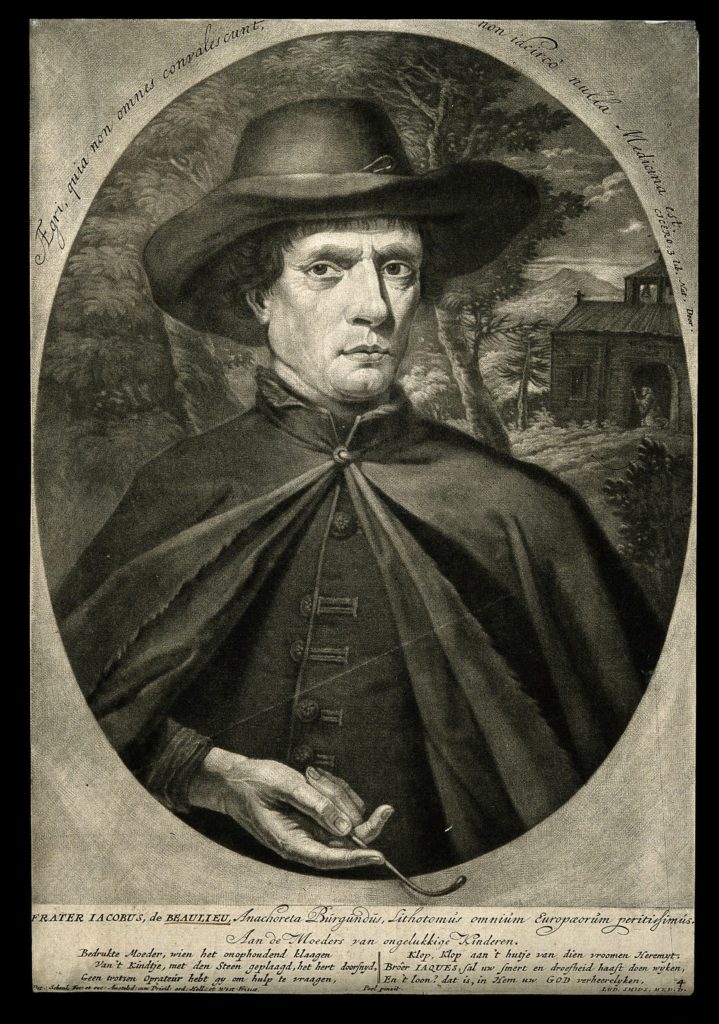Jacques de Beaulieu (1651-1714)
In 1651, a boy was born in a small hamlet in Burgundy who would completely change the method of cutting for the bladder stone and whose name is imortalised not by urologists but by children in the nursery rhyme, Frère Jacques.
The true historical details are complicated by reports, stories and biographies biased by friends and enemies of Jacques in an age of jealous surgeons clinging to mediaeval practices, the French aristocracy of the royal court looking for the latest fashionable person of interest and stone sufferers who faced high mortality, however their stones were managed.
Our nursery rhyme character was born of very poor parents, it is said, in the hamlet of Etendonne near the village of Langsauniere in the parish of Beaufort, Burgundy. Initially, he served in the army, as a trooper in the French Cavalry, but at some point met an itinerent Italian lithotomist called Pauloni. Beaulieu joined him and learned his method of cutting for the stone, fistula and hernia. He began to travel around France, treating patients in one place before moving on to the next village.
At about the age of 40, Jacques took on the practices and dress of a monk. He never joined a formal religious order but dressed as a Récollet Franciscian Friar but with a large hat rather than a cowl and slippers rather than sandles on his feet. It would appear he did indeed lead a humble life, eating little and taking only a few coins as a fee, to enable him to repair his instruments and slippers.
In 1697, encouraged by a priest he had operated on, he went to Paris. Initially, and perhaps understandably, he was turned away from Hôpital de la Charité. However, with a letter of introduction from Notre Dame he approached Achille de Harlay comte de Beaumont (1639-1712) the President of the Parliament of Paris. He ordered the surgeons to test Frère Jacques, so a cadaver was prepared with a bladder stone placed suprapubically. Jean Méry (1645 – 1722), surgeon to the Hôtel Dieu disected the cadaver after Frère Jacques had cut out the stone perineally, using his method. Initially, Méry reported a clean cut between the ischio cavernosus and bulbo cavernosus. However, a few days later Jacques was tested on two more cadavers, a young boy’s and a woman’s. Méry now found he had sliced through the urethra of the boy and opened the vagina of the woman; he retracted his support because of this but probably also for financial or political reasons – the established surgeons did not want a new operation or indeed surgeon to surplant their well paid methods.
Frère Jacques took his practice to the Royal Court at Fontainebleau and after a successful operation on a shoemaker’s apprentice, gained some support, including from the King, and continued operating there. He later returned to Paris with the Court and the surgeons were once again obliged to test him.
An enquiry was set up the following Spring in the Archbishop’s palace to decide if Frère Jacques could operate. Despite the surgeons’ warnings, he was granted rights to operate at La Charité and the Hôtel Dieu. Unfortunately, his bold skill was no match for his lack of anatomical knowledge, of 60 patients cut, 25 died, 13 were cured but the remaining 22 remained in hospital crippled.
He left Paris and then France and eventually ended up in Amsterdam where he was well received and observed by Johannes Jacobus Rau (1668-1719) the famous anatomist. Rau studied Frère Jacques’ method and, applying his anatomical knowledge, standardised it.
In 1700, Frère Jacques was invited back to Paris by the Royal physician Guy-Crescent Fagon (1638 – 1718). He had Jacques instructed in anatomy to enable him to understand where he was cutting and what to avoid. He also changed his old large round sound to a groved one to increase the acuracy of his cut. Now with anatomical knowledge and a method improved and observed by his mentors, his success rate hugely improved. He continued to travel Europe until at least 1713 when he finally returned home and died at around the age of 70 still living the humble life of a poor monk.
Jacques de Beaulieu was an itinerent lithotomist, trained by apprenticeship; these stone cutters had served their patients for better or worse since ancient times. He clearly had some skill, but lack of anatomical knowledge led a high morbidity and mortality. He did however bring a new technique of perineal lithotomy that, after the aplication of anatomical knowledge was superior to the old Marian method. Although, eventually, he carried out his surgery more safely, it is his introduction of this new method to the medical world for which he should be celebrated. Swiftly picked up by surgical masters such as Rau in Amsterdam, Georges Mareschal (1658 – 1736) of Paris and William Cheselden (1688 – 1752) of England, lateral lithotomy became the standard technique until the end of the C19th.
“A man of undoutable boldness; he never, in time of operation, was seen to faulter, or seem dismayed: he has a firm and steady hand; never perhaps has there been seen a more daring operator: he is withal pious and charitable, and it were greatly to be wished that such a man were better instruded in the anatomy of the parts” wrote Jean Méry; praise indeed from a surgeon who remained forever opposed to Frère Jacques.





